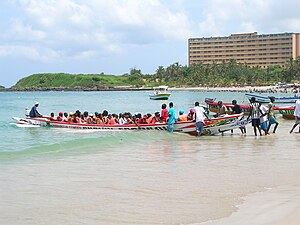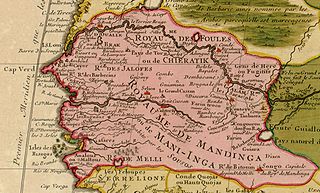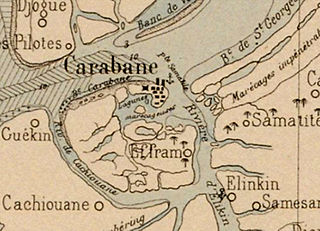




Tourism in Senegal is a vital part of the West African nation's economy.





Tourism in Senegal is a vital part of the West African nation's economy.
From a relatively small industry at the introduction of the first Club Med resort in the 1970s, tourism has grown to be an important part of the Senegalese economy. Since the 1990s, Senegal has made an effort to reach beyond visitors from the former colonial power France and is attracting tourists from Spain, Britain and Italy, in part motivated by the example of neighboring Gambia, which draws a relatively larger tourist share from Northern Europe and the Americas to its Banjul coastal resorts. [1]
In 2008, Senegal's foreign tourist visitors had reached 1 million, attracted to luxury beach resorts, natural and historic sites. The return rate for visitors stood at around 30% in 2008. [1]
Future projections and bookings announced in 2009 raised fears that the global economic downturn would deal a blow to 2009 and 2010 tourist visits, with a booking rate down from 30% the year before to 5%. [1]
U.S. tourists - often African-Americans - are increasing in numbers, drawn in particular by the historic slave trading post of Goree Island. [2]
Principal cities of interest include the capital, Dakar; Saint-Louis, an old colonial town; and the Mouride holy centre of Touba. Gorée Island, formerly a centre of the West African slave trade and a UNESCO World Heritage Site, draws many visitors.
Most tourists from outside Africa are Europeans, especially French, and a hotel and resort industry centered on enclosed beach resorts, most at resort towns like Saly on the Petite Côte south of Dakar, have been created to appeal to this clientele since the 1970s. [3]
Resort vacations are often supplemented by wildlife and nature tours of areas like the Sine-Saloum Delta, the Grande Côte (north of Dakar), the Lac Rose, and Senegal River delta in the north (near Saint-Louis). Historic sites around Dakar, Gorée Island, Museums, and monuments draw visitors. To the north, the colonial island town of Saint-Louis is visited for its long history and colonial architecture. There are also safari trips offered to see wildlife, perhaps limited by east or South African standards. [3]
Senegal is considered to be one of the best places in the world to catch Sailfish. [4]
Senegal has a small but developing National Park and Reserve System. Notable among these are the Langue de Barbarie National Park and Djoudj National Bird Sanctuary which provide wildlife habitat in the dunes and mangrove swamps surrounding the mouth of the Senegal River near city of Saint-Louis. [5]
The Niokolo-Koba National Park is a World Heritage Site and natural protected area in south eastern Senegal near the Guinea-Bissau border which protects a large variety of wild animals, including hippopotamuses, elephants, and lions. Largely undeveloped, the area is remote and lacks tourist infrastructure, but is a destination for specialty tours. [5]
The Basse Casamance National Park, in the far southwest, includes both ecotourism and tropical forest excursions, and a popular coastal beach resort aimed at foreign tourism. The Casamance conflict has hindered tourist development in this area. The Park has been closed now for a number of years due to rebel activity and mines. On attempting to enter the park (Jan 2019) via Emaye I was turned back by heavily armed army personnel, in no uncertain terms. [5]
The Saloum Delta National Park is a large area of mangrove estuaries and islands, visited by tourists for it wildlife, its cultural interest as the home of the minority Serer people, and its proximity to the tourist resorts of the Petite-Côte. Smaller parks and reserves, like the Guembeul Natural Reserve in the center west or the Bandia Natural Reserve near Dakar exit primarily for the more conventional European tourist industry, resembling Wildlife Parks or zoos. [5]
Senegal has a middle class prosperous enough to support local tourism, as well a large population of Senegalese living abroad. Apart from visits to family and friends, the city of Dakar supports a local industry of holiday spots frequented by city dwellers. The beaches and islands to the north of the city, at places like Yoff and Ngor, are particularly popular for Senegalese tourists. Senegalese, other African visitors, and expatriates often travel to religious sites and festivals, especially those connected with powerful Sufi Muslim brotherhoods of Senegal. Visit travel blog
The main entrance point is Dakar-Blaise Diagne International Airport. Senegal’s capital city of Dakar, on the westernmost point of the continent, is strategically located. [2]
European flights into Dakar are populated by a mix of Senegalese living abroad, African travelers making connections, western European tourists, and a recent surge in Asian workers traveling to work on Chinese government-funded construction projects. [3]
United States based Delta Air Lines opened in December 2006 an Atlanta-Dakar-Johannesburg-Dakar-Atlanta route. [2] The Open Skies Agreement between the U.S. and Senegal signed in January 2001 laid the foundation for direct routes between the U.S. and Senegal by U.S. carriers. [2]
British based travel companies, long organising trips to neighbouring anglophone Gambia, have begun entering a package travel market to Senegal which was until recently dominated by French and Belgian companies. [3]
Regulation, promotion and development of the nation's tourist sector is the remit of Senegal's Ministry of Senegalese Overseas and Tourism (Ministère des Sénégalais de l'Extérieur et du Tourisme (SENEX) or sometimes Ministère des Sénégalais de L'extérieur, de L'artisanat et du Tourisme). [6]
A number of agencies, boards, and partnerships which administer promote and regulate the Senegalese tourism sector report to this ministry. These include the Directorate for the Study and Planning of Tourism (Direction des Etudes et de la Planification touristique), the Directorate of Tourism Regulation and Structure (Direction de la Réglementation et de l’Encadrement du Tourisme), and the National Tourist Promotion Board (Agence nationale de la Promotion touristique - ANPT). [6]
In addition, offices of the Ministry specialise in Tourist industry infrastructural and promotion funding (the Secrétariat du Comité de Gestion du Fonds de Promotion Touristique) and oversea a Tourist industry training school (the Secrétariat du Comité de Gestion du Fonds de Promotion Touristique - ENFHT). [6]

The history of Senegal is commonly divided into a number of periods, encompassing the prehistoric era, the precolonial period, colonialism, and the contemporary era.

The economy of Senegal is driven by mining, construction, tourism, fishing and agriculture, which are the main sources of employment in rural areas, despite abundant natural resources in iron, zircon, gas, gold, phosphates, and numerous oil discoveries recently. Senegal's economy gains most of its foreign exchange from fish, phosphates, groundnuts, tourism, and services. As one of the dominant parts of the economy, the agricultural sector of Senegal is highly vulnerable to environmental conditions, such as variations in rainfall and climate change, and changes in world commodity prices.

Saint Louis or Saint-Louis, is the capital of Senegal's Saint-Louis Region. Located in the northwest of Senegal, near the mouth of the Senegal River, and 320 kilometres (200 mi) north of Senegal's capital city Dakar, it has a population officially estimated at 258,592 in 2021. Saint-Louis was the capital of the French colony of Senegal from 1673 until 1902 and French West Africa from 1895 until 1902, when the capital was moved to Dakar. From 1920 to 1957, it also served as the capital of the neighboring colony of Mauritania.

Île de Gorée is one of the 19 communes d'arrondissement of the city of Dakar, Senegal. It is an 18.2-hectare (45-acre) island located 2 kilometres at sea from the main harbour of Dakar, famous as a destination for people interested in the Atlantic slave trade.

The Société des établissements de plein air du Québec, also known as Sépaq, is the agency of the Government of Quebec that manages parks and wildlife reserves. Sépaq falls under the authority of the Minister of Développement durable, de l'Environnement et des Parcs and its head office is located in Quebec City. It employs about 3400 people.

According to the Government of Burkina Faso, 433,778 tourists visited the country in 2011.

The House of Slaves and its Door of No Return is a museum and memorial to the victims of the Atlantic slave trade on Gorée Island, 3 km off the coast of the city of Dakar, Senegal. Its museum, which was opened in 1962 and curated until Boubacar Joseph Ndiaye's death in 2009, is said to memorialise the final exit point of the slaves from Africa. While historians differ on how many African slaves were actually held in this building, as well as the relative importance of Gorée Island as a point on the Atlantic slave trade, visitors from Africa, Europe, and the Americas continue to make it an important place to remember the human toll of African slavery.

The following outline is provided as an overview of and topical guide to Senegal:

Tourism in Tunisia is an industry that generates around 9.4 million arrivals per year in 2016, 2017, 2018, 2019 & 2020, which makes it one of the most visited countries in Africa. Tunisia has been an attractive destination for tourists since the beginning of the 1960s.

Tourism is an important part of the economy of Réunion, an island and French overseas departement in the Indian Ocean. Despite its many tourism assets, the island's tourist attractions are not well known.

Carabane, also known as Karabane, is an island and a village located in the extreme south-west of Senegal, in the mouth of the Casamance River. This relatively recent geological formation consists of a shoal and alluvium to which soil is added by accumulation in the branches and roots of the mangrove trees which cover most of the island. Along with the rest of Ziguinchor Region, Carabane has a tropical climate, cycling between a dry season and a wet season. The island was once considered an arid location where no useful plants were likely to grow, but it now supports several types of fruit tree, the most common of which are mangos and oranges. Although the nearby Basse Casamance National Park and Kalissaye Avifaunal Reserve have been closed for years because of the Casamance Conflict, Carabane has continued to attract ornithologists interested in its wide variety of birds. Various species of fish are plentiful around the island, but there are very few mammals.
Saly is a seaside resort area in Thiès Region on the Petite Côte of Senegal, south of Dakar. It is the top tourist destination in all of West Africa and has the status of a commune.
Tourism is an important industry in Montreal, Quebec, Canada. The city welcomed 10.2 million overnight visitors in 2016 and 11,792,970 day trip visitors in 2010. Montreal attracted 1,770,939 international overnight visitors in 2010, most of them from the United States, France, the United Kingdom, Germany, Mexico and Japan. 82,740 direct jobs and 48,199 indirect jobs in Montreal were generated by the tourism industry in 2014.

The Henriette-Bathily Women's Museum is a museum which was located on Gorée, an island on the coast of Senegal, across from the House of Slaves museum. In May 2015, it moved to Dakar, at the Place du Souvenir Africain et de la Diaspora . A project conceived in 1987 by the filmmaker Ousmane William Mbaye, it was opened in 1994 under the direction of Annette Mbaye d'Erneville.
The following is a timeline of the history of the city of Dakar, Senegal.
The Nationale 1 Masculin is the highest professional basketball league in Senegal. Established in 1971, the league consists of 16 teams.
Mauricie tourism represents an important sector of Québec’s economy with 1.2 to 1.5 million visitors each year who spend 200 to 300 million dollars per year in tourist attractions and services. In 2011, 90% of tourists in Mauricie were Quebecers, 3% came from other Canadian provenances, 2% from the United States, and 4% from others.

Ziguinchor is the capital of the Ziguinchor Region, and the chief town of the Casamance area of Senegal, lying at the mouth of the Casamance River. It has a population of over 230,000. It is the seventh largest city of Senegal, but largely separated from the north of the country by The Gambia.
Ministry of Tourism, also known as the Ministry of Tourism and Air Transport, is a government ministry of Senegal. Its head office is on the 8th floor of the Immeuble Y2 Cité Keur Goorgui in Dakar.
Maïmouna Ndoye Seck is a Senegalese politician. An alumnus of the Ecole Polytechnique of Thiès, she was the Minister of Energy from 2013 to 2015 and the Minister of Tourism and Air Transport from 2015 to 2017, before she became the Minister of Air Transport and Airport Facilities Development in September 2017.